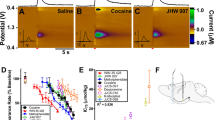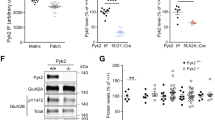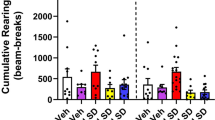Abstract
Caffeine has been imbibed since ancient times in tea and coffee, and more recently in colas. Caffeine owes its psychostimulant action to a blockade of adenosine A2A receptors1, but little is known about its intracellular mechanism of action. Here we show that the stimulatory effect of caffeine on motor activity in mice was greatly reduced following genetic deletion of DARPP-32 (dopamine- and cyclic AMP-regulated phosphoprotein of relative molecular mass 32,000)2. Results virtually identical to those seen with caffeine were obtained with the selective A2A antagonist SCH 58261. The depressant effect of the A2A receptor agonist, CGS 21680, on motor activity was also greatly attenuated in DARPP-32 knockout mice. In support of a role for DARPP-32 in the action of caffeine, we found that, in striata of intact mice, caffeine increased the state of phosphorylation of DARPP-32 at Thr 75. Caffeine increased Thr 75 phosphorylation through inhibition of PP-2A-catalysed dephosphorylation, rather than through stimulation of cyclin-dependent kinase 5 (Cdk5)-catalysed phosphorylation, of this residue. Together, these studies demonstrate the involvement of DARPP-32 and its phosphorylation/dephosphorylation in the stimulant action of caffeine.
This is a preview of subscription content, access via your institution
Access options
Subscribe to this journal
Receive 51 print issues and online access
$199.00 per year
only $3.90 per issue
Buy this article
- Purchase on Springer Link
- Instant access to full article PDF
Prices may be subject to local taxes which are calculated during checkout





Similar content being viewed by others
References
Fredholm, B. B., Battig, K., Holmen, J., Nehlig, A. & Zvartau, E. E. Actions of caffeine in the brain with special reference to factors that contribute to its widespread use. Pharmacol. Rev. 51, 83–133 (1999)
Walaas, S. I., Aswad, D. W. & Greengard, P. DARPP-32, a dopamine- and cAMP-regulated phosphoprotein enriched in dopamine-innervated brain regions. Nature 301, 69–71 (1983)
Gerfen, C. R. The neostriatal mosaic: multiple levels of compartmental organization in the basal ganglia. Annu. Rev. Neurosci. 15, 285–320 (1992)
Schiffman, S. N. & Vanderhaeghen, J.-J. Adenosine A2 receptors regulate the gene expression of striatopallidal and striatonigral neurons. J. Neurosci. 13, 1080–1087 (1993)
Fink, J. S. et al. Molecular cloning of the rat A2 adenosine receptor: selective co-expression with D2 dopamine receptor in rat striatum. Mol. Brain Res. 14, 186–195 (1992)
Kull, B., Svenningsson, P. & Fredholm, B. B. Adenosine A2A receptors are colocalized with and activate Golf in rat striatum. Mol. Pharmacol. 58, 771–777 (2000)
Fredholm, B. B. Activation of adenylate cyclase from rat striatum and tuberculum olfactorium by adenosine. Med. Biol. 55, 262–267 (1977)
Ledent, C. et al. Aggressiveness, hypoalgesia and increased blood pressure in mice deficient for the adenosine A2a receptor. Nature 388, 674–678 (1997)
El Yacoubi, M. et al. The stimulant effects of caffeine on locomotor behaviour in mice are mediated through its blockade of adenosine A(2A) receptors. Br. J. Pharmacol. 129, 1465–1473 (2000)
Ouimet, C. C., Langley-Guillion, K.-C. & Greengard, P. Quantitative immunochemistry of DARPP-32-expressing neurons in the rat caudatoputamen. Brain Res. 808, 8–12 (1998)
Snyder, S. H., Katims, J. J., Annau, Z., Bruns, R. F. & Daly, J. W. Adenosine receptors and the behavioural actions of methylxanthines. Proc. Natl Acad. Sci. USA 78, 3260–3264 (1981)
Bibb, J. et al. Phosphorylation of DARPP-32 by Cdk5 modulates dopamine signalling in neurons. Nature 402, 669–671 (1999)
Nishi, A., Snyder, G. L., Nairn, A. C. & Greengard, P. Role of calcineurin and protein phosphatase-2A in the regulation of DARPP-32 dephosphorylation in neostriatal neurons. J. Neurochem. 72, 2015–2021 (1999)
Nishi, A. et al. Amplification of dopaminergic signalling by a positive feedback loop. Proc. Natl Acad. Sci. USA 97, 12840–12845 (2000)
Ongini, E. SCH 58261: a selective A2A adenosine receptor antagonist. Drug Dev. Res. 42, 63–70 (1997)
Ehrlich, M. E., Kurihara, T. & Greengard, P. Rat DARPP-32: cloning, sequencing, and characterization of the cDNA. J. Mol. Neurosci. 2, 1–10 (1990)
Le Moine, C. & Bloch, B. D1 and D2 dopamine receptors gene expression in the rat striatum: sensitive cRNA probes demonstrate prominent segregation of D1 and D2 mRNA in distinct neuronal population of the dorsal and ventral striatum. J. Comp. Neurol. 355, 418–427 (1995)
Svenningsson, P. et al. Dopamine D1 receptor-induced gene transcription is modulated by DARPP-32. J. Neurochem. 75, 248–257 (2000)
Ögren, S.-Ö., Köhler, C., Fuxe, K. & Ängeby, K. in Dopaminergic Ergot Derivatives and Motor Function (eds Fuxe, K. & Calne, D. B.) 225–266 (Pergamon, Oxford, 1979)
Fienberg, A. A. et al. DARPP-32: regulator of the efficacy of dopaminergic neurotransmission. Science 281, 838–842 (1998)
Hemmings, H. C. J. & Greengard, P. DARPP-32, a dopamine- and adenosine 3′:5′-monophosphate-regulated phosphoprotein: regional, tissue, and phylogenetic distribution. J. Neurosci. 6, 1469–1481 (1986)
Liu, F. et al. Regulation of cyclin-dependent kinase 5 and casein kinase 1 by metabotropic glutamate receptors. Proc. Natl Acad. Sci. USA 98, 11062–11068 (2001)
Rimondini, R., Ferré, S., Giménez-Llort, L., Ögren, S.-O. & Fuxe, K. Differential effects of selective adenosine A1 and A2 receptor agonists on dopamine receptor agonist-induced behavioural responses in rats. Eur. J. Pharmacol. 347, 153–158 (1998)
Kafka, S. H. & Corbett, R. Selective adenosine A2A receptor/dopamine D2 receptor interactions in animal models of schizophrenia. Eur. J. Pharmacol. 295, 147–154 (1996)
Svenningsson, P. et al. Regulation of the phosphorylation of the dopamine- and cAMP-regulated phosphoprotein of 32 kDa in vivo by dopamine D1, dopamine D2, and adenosine A2A receptors. Proc. Natl Acad. Sci. USA 97, 1856–1860 (2000)
Acknowledgements
We thank R. Rimondini and S.-O. Ögren for help in performing behavioural experiments and A. Nishi for discussions. This work was supported by the Swedish Research Council (G.F. and B.B.F.), the Swedish Society for Medical Research (M.L.), the Foundation Blanceflor Boncompagni-Ludovisi, née Bildt (L.P.) and by funding from the National Institute of Mental Health and the National Institute of Drug Abuse (A.C.N. and P.G.).
Author information
Authors and Affiliations
Corresponding author
Ethics declarations
Competing interests
The authors declare that they have no competing financial interests.
Rights and permissions
About this article
Cite this article
Lindskog, M., Svenningsson, P., Pozzi, L. et al. Involvement of DARPP-32 phosphorylation in the stimulant action of caffeine. Nature 418, 774–778 (2002). https://doi.org/10.1038/nature00817
Received:
Accepted:
Issue Date:
DOI: https://doi.org/10.1038/nature00817
This article is cited by
-
Caffeine Improves GABA Transport in the Striatum of Spontaneously Hypertensive Rats (SHR)
Neurotoxicity Research (2021)
-
Purinergic Receptors in Basal Ganglia Diseases: Shared Molecular Mechanisms between Huntington’s and Parkinson’s Disease
Neuroscience Bulletin (2020)
-
Rhes influences striatal cAMP/PKA-dependent signaling and synaptic plasticity in a gender-sensitive fashion
Scientific Reports (2015)
-
DARPP-32 interaction with adducin may mediate rapid environmental effects on striatal neurons
Nature Communications (2015)
-
Make Caffeine Visible: a Fluorescent Caffeine “Traffic Light” Detector
Scientific Reports (2013)
Comments
By submitting a comment you agree to abide by our Terms and Community Guidelines. If you find something abusive or that does not comply with our terms or guidelines please flag it as inappropriate.



